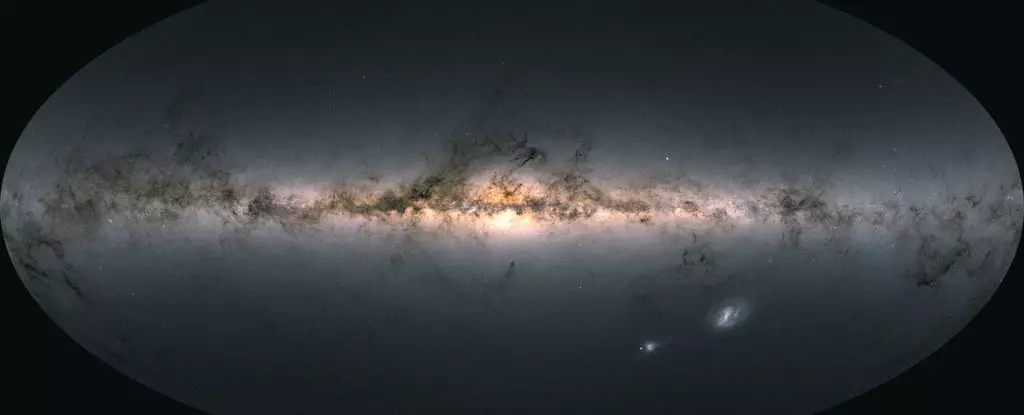In an intriguing twist on galactic dynamics, scientists have unearthed a possible supermassive black hole situated in the Large Magellanic Cloud (LMC), a dwarf galaxy on a collision course with our own Milky Way. This revelation is underscored by the observation of a massive, elusive entity believed to possess a mass around 600,000 times that of the Sun. As the LMC gradually draws near to the Milky Way, the prospect of this black hole joining the cosmic fray grows increasingly plausible. The detection of such a black hole, if validated, could provide invaluable insights into the processes that enable black holes to evolve from relatively modest sizes to titanic behemoths, potentially rivaling the mass of billions of Suns.
The quest to detect black holes is fraught with complexities, primarily because they do not emit detectable radiation unless they are actively engaging in the consumption of surrounding matter. Typically, this accretion process generates intense light as the material is subjected to extreme gravitational forces and friction, yielding observable emissions. However, when black holes lie dormant, they become nearly invisible, prompting astronomers to adopt creative methodologies for identification. Traditionally, this search hinges on anomalies in stellar orbits resulting from the gravitational influence of the black hole. The discovery of Sagittarius A*, the supermassive black hole at the Milky Way’s core, is a testament to the power of this approach.
Unlike previous research that focused on stellar orbits, the team led by Jiwon Jesse Han took a distinctive approach by examining hypervelocity stars—celestial bodies that move at velocities exceeding typical star speeds. These extraordinary stars, which have the potential to escape the gravitational pull of their home galaxies, are thought to be accelerated through an interaction involving a black hole and two companion stars, a mechanism known as the Hills mechanism. Through this intricate gravitational dance, stars can be flung into hypervelocity trajectories, providing a pathway to identify hidden black holes in their vicinity.
The analysis utilized data from the recently retired Gaia space telescope, which meticulously mapped the Milky Way’s three-dimensional layout and the motions of its stellar inhabitants. By scrutinizing 21 hypervelocity stars identified in the galaxy’s outer halo, Han and colleagues were able to draw correlations with the Hills mechanism, thus implying the existence of a hidden black hole within the LMC. Among these stars was a subset originating close to Sagittarius A*, and rather compellingly, several appeared to trace back to the Large Magellanic Cloud.
The connection between hypervelocity stars and the hypothesized black hole in the LMC highlights the intricate interplay between these celestial objects. The research findings indicate that the stellar ejections were consistent with an object of approximately 600,000 solar masses. As the LMC, currently orbiting the Milky Way at an estimated distance of 160,000 light-years, continues its slow journey towards a collision—predicted to occur in roughly 2 billion years—it raises questions about the future dynamics of our galactic neighborhood.
As the two galaxies merge, the anticipated gravitational interactions could lead to the supermassive black hole from the LMC drifting toward the Milky Way’s galactic center to eventually converge with Sagittarius A*. This merger could serve as a significant mechanism by which black holes grow larger over cosmic timescales, offering a rare observational opportunity to witness the evolution of these enigmatic entities.
The Broader Implications of the Discovery
The implications of confirming the existence of this black hole, as suggested by the detected hypervelocity stars, extend far beyond the scientific novelty of a new astronomical finding. This research offers fresh perspectives on the growth patterns and evolutionary mechanisms of black holes universally. As researchers embark on the next phase of their investigation—seeking to substantiate the claims and further explore the properties of this hidden black hole—our understanding of cosmic history and the lifecycle of galaxies will undoubtedly deepen.
The anticipated legacy of this research could not only refine our models of galaxy mergers but also reshape our understanding of black holes as fundamental components of galaxy formation and evolution. Even though we may not witness these dramatic cosmic events in our lifetime, the potential to unravel the enigmas of the universe continues to inspire scientific inquiry and excitement. As we stand at the brink of such discoveries, the cosmos reveals its intricate and enthralling narratives, reminding us how much more there is to explore in our ever-expanding universe.

